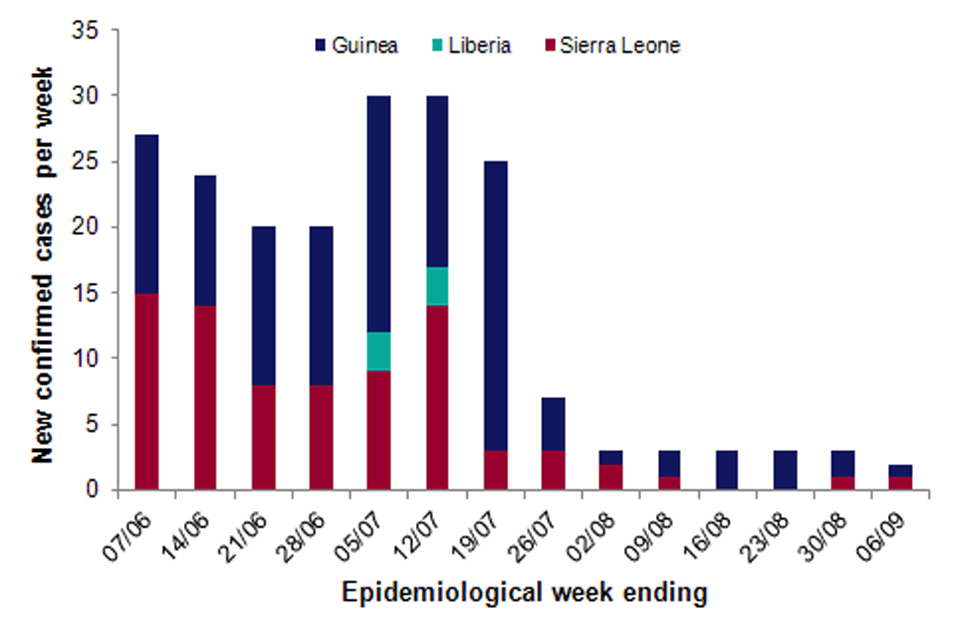HPR volume 9 issue 32: news and travel (11 September)
Updated 29 December 2015
1. WHO update on international MERS-CoV situation
Middle East respiratory syndrome (MERS) poses an emerging infectious disease hazard for humans, with transmission of the MERS coronavirus (MERS-CoV) continuing both from camels to humans in the Arabian peninsula, and more widely, between humans, particularly in healthcare settings which have provided the conduit for propagation of infection in a number of recent outbreaks.
Following its tenth Emergency Committee meeting on the subject, on 2 September, the World Health Organization issued a statement stressing the continuing need for awareness in healthcare settings of the potential for human-to-human transmission from patients with unrecognised MERS infection [1]. WHO stated there was still insufficient awareness among the global public health community of the potential for further outbreaks; nor had its earlier advice on the sharing of information of public health importance – including from research studies in affected countries and from virological surveillance – been completely followed.
As a result, significant outbreaks had recently been associated with nosocomial transmission – in the Kingdom of Saudi Arabia (KSA), in Jordan and in Korea. The WHO statement notes that the Korean outbreak illustrated how, “when the MERS virus appears in a new setting, there is a great potential for widespread transmission and severe disruption to the health system and to society”.
The WHO meeting had considered evidence from the countries most affected in the Middle East – KSA, Jordan, and UAE – and also from the Philippines, Thailand and Korea, which have experienced outbreaks triggered by imported cases.
The overall risk to the UK of MERS-CoV remains low, according to PHE’s latest risk assessment [2], but the possibility of imported cases remains and testing is recommended for persons with a history of travel to, or residence in an area where infection with MERS-CoV could have been acquired in the 14 days before symptom onset.
These criteria currently cover: Bahrain, Jordan, Iraq, Iran, Kingdom of Saudi Arabia, Kuwait, Oman, Qatar, United Arab Emirates , Yemen and South Korea. Algorithms for the identification of cases, and related guidance, are available on the PHE MERS-CoV webpages [3].
1.1 References
-
WHO (3 September 2015). WHO statement on the tenth meeting of the IHR Emergency Committee regarding MERS.
-
PHE (updated August 2015). Risk assessment of Middle East respiratory syndrome coronavirus (MERS-CoV.
-
PHE Middle East respiratory syndrome coronavirus (MERS-CoV): clinical management and guidance webpages.
2. Updated WHO WPV recommendations and vaccine-derived poliovirus in Ukraine
Precautionary advice for travellers from England, Wales and Northern Ireland visiting countries variously affected by wild poliovirus (WPV) has been revised following a sixth meeting, on 17 August, of the WHO’s International Health Regulations emergency committee concerned with WPV [1].
In particular, following the confirmation of a vaccine-derived polio outbreak in the south west of Ukraine, PHE has issued recommendations specifically relating to individuals and families travelling to, or from, that country which, for travel purposes, has been added to the list of countries classified as being infected with polio but not actively exporting the virus [2,3].
2.1 References
-
WHO (17 August 2015). Statement on the sixth IHR Emergency Committee meeting regarding the international spread of wild poliovirus.
-
NaTHNaC (7 September 2015). Circulating vaccine derived polio virus (cVDPV): Ukraine.
-
WHO (1 September 2015). Circulating vaccine-derived poliovirus – Ukraine.
3. Ebola virus disease: international epidemiology summary (at 5/6 September 2015)
This week marks the one year anniversary of the publication of the first PHE weekly epidemiology update on the EVD outbreak in West Africa. In the week to 5 September 2014 (the period covered by the first report), over 600 confirmed cases (and many more probable and suspected cases) were reported in Guinea, Liberia and Sierra Leone, and the Nigerian outbreak which began in Lagos had spread to Port Harcourt. The reduction in case incidence to consistently low levels (figure 1) signifies the tremendous achievement made by EVD response teams in affected countries to not only stem transmission but also engage communities with control measures. While such progress needs to recognised and applauded, significant and continued effort is required to finally halt the outbreak.
As of 6 September 2015, a total of 28,183 clinically compatible cases of Ebola virus disease (15,228 confirmed) have been reported associated with the West African outbreak, 11,306 of which have died. There were two confirmed cases reported this week: one in Guinea and one in Sierra Leone, both in registered contacts. Case incidence has remained between two and three confirmed cases for six consecutive weeks.
The Guinean case, a 13 year old girl, was a registered contact and relative of two previous cases recently reported in the capital Conakry. Further cases are anticipated associated with this transmission chain.
The case reported in Sierra Leone was the daughter of last week’s case in Kambia and had been caring for her mother during the course of her illness. Over 900 contacts have been identified associated with this cluster of which ~40 are considered high risk.
A total of 1,281 contacts remain under follow up (292 in Guinea and 989 in Sierra Leone), rising from 458 in the previous week.
Liberia remains within a 90 day period of heightened vigilance following being declared EVD transmission free on 3 September 2015.

Number of new confirmed cases reported per week (7 June to 6 September 2015) in affected countries in West Africa. (Data source: WHO Ebola Situation Report 9 September 2015)
Further information on the epidemiological situation can be found in PHE’s weekly Ebola epidemiological update and from the Ebola outbreak distribution map.
